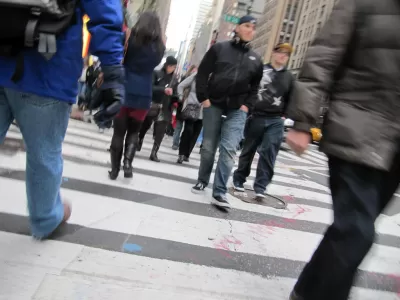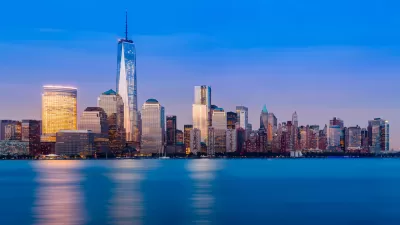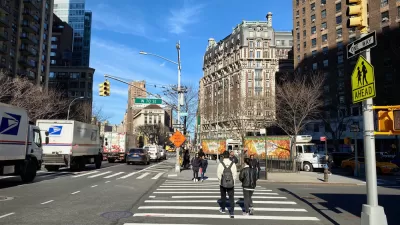In the 1970s, the fear of getting mugged had some NYC pedestrians walking in the street. Nowadays, commuters are sharing space with cars for a very different reason: the sidewalks are too crowded.

Winnie Hu reports on a very New York phenomenon: veteran sidewalkers moving onto the street to bypass the crowd. One commuter reports that she "prefers dodging yellow cabs and bicyclists to navigating sidewalks teeming with commuters, tourists and cart-pushing vendors, all jostling for elbow room."
The problem is acute in Manhattan, where residents, commuters, and tourists mingle to take advantage of the nation's one truly pedestrian-focused city. As the city continues its boom, crowding has pushed many sidewalks to the limit.
The city has responded by "adding more pedestrian plazas across the city, expanding the presence of a streetscape feature first embraced by the administration of Mayor Michael R. Bloomberg. One is scheduled to open soon on 33rd Street near Penn Station. There are also plans to widen a half-dozen sidewalks in Flushing, Queens, in the next year."
On one hand, sidewalks are a shared space where all kinds of people can interact, making for a more cosmopolitan city. On the other, overcrowding can foul those waters. "Space on New York's sidewalks is at a premium at a time when the city's population of 8.5 million is higher than ever. Add in the record 59.7 million visitors who are expected to descend on the city this year, up from 48.8 million in 2010, and it is a recipe for thoroughfares packed like sardine cans."
And any urban pedestrian knows that other people aren't the only obstacle. "The problem was aggravated in some areas by sidewalk clutter such as construction scaffolding, large garbage bags, vendors and fixtures like lights, signs, newsstands, benches, planters and recycling bins."
FULL STORY: New York’s Sidewalks Are So Packed, Pedestrians Are Taking to the Streets

Planetizen Federal Action Tracker
A weekly monitor of how Trump’s orders and actions are impacting planners and planning in America.

Restaurant Patios Were a Pandemic Win — Why Were They so Hard to Keep?
Social distancing requirements and changes in travel patterns prompted cities to pilot new uses for street and sidewalk space. Then it got complicated.

Map: Where Senate Republicans Want to Sell Your Public Lands
For public land advocates, the Senate Republicans’ proposal to sell millions of acres of public land in the West is “the biggest fight of their careers.”

Maui's Vacation Rental Debate Turns Ugly
Verbal attacks, misinformation campaigns and fistfights plague a high-stakes debate to convert thousands of vacation rentals into long-term housing.

San Francisco Suspends Traffic Calming Amidst Record Deaths
Citing “a challenging fiscal landscape,” the city will cease the program on the heels of 42 traffic deaths, including 24 pedestrians.

California Homeless Arrests, Citations Spike After Ruling
An investigation reveals that anti-homeless actions increased up to 500% after Grants Pass v. Johnson — even in cities claiming no policy change.
Urban Design for Planners 1: Software Tools
This six-course series explores essential urban design concepts using open source software and equips planners with the tools they need to participate fully in the urban design process.
Planning for Universal Design
Learn the tools for implementing Universal Design in planning regulations.
Heyer Gruel & Associates PA
JM Goldson LLC
Custer County Colorado
City of Camden Redevelopment Agency
City of Astoria
Transportation Research & Education Center (TREC) at Portland State University
Camden Redevelopment Agency
City of Claremont
Municipality of Princeton (NJ)




























